In tracing first origins and subsequent life-results through intra-chronology links, the following is used: e.g. at 1860 [1897], and/or at 1897 [1860]. Illustrations and captions added by J.B.
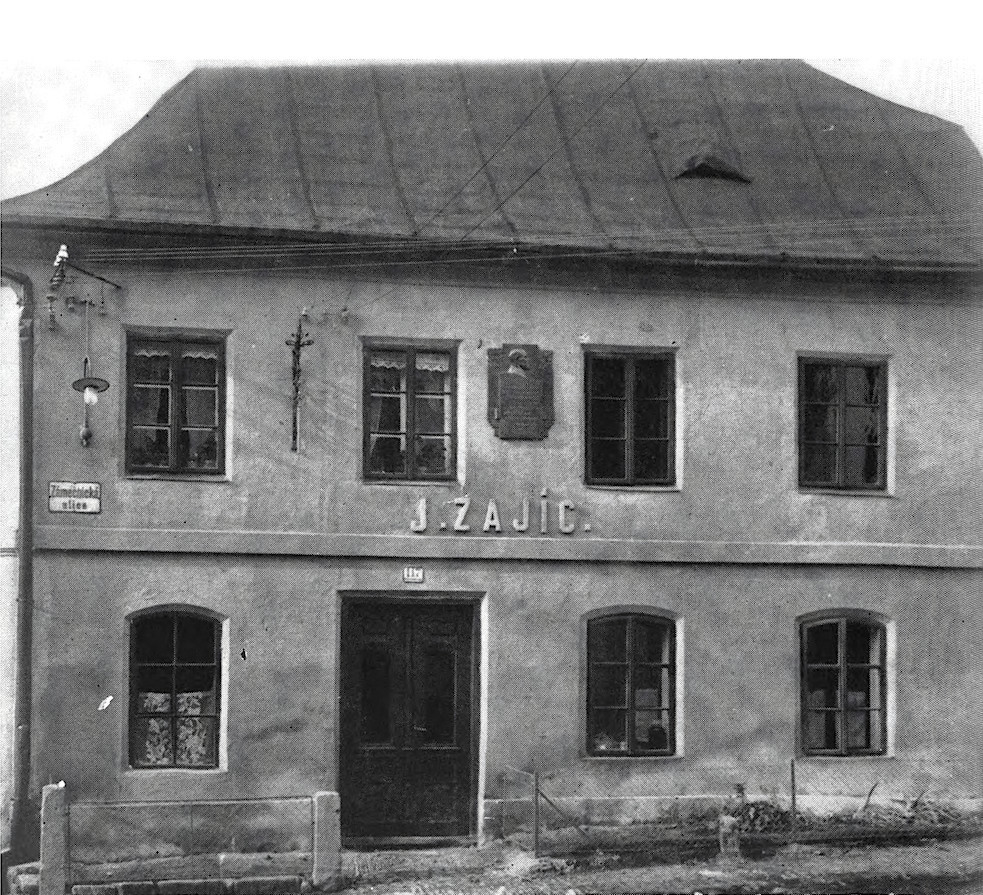
Freud's birthplace (APA frontispiece).
1856. Born at home, Schlossergasse Street, Freiberg, Moravia, part of Czechoslovakia from 1919-1939. "My parents were Jews, and I have remained a Jew myself," he would later tell the world (Freud, 1925). The father Jakob Freud, 1815-1896, a wool merchant, in 1855 at Vienna married his second wife, Amalie Nathansohn, 1835-1930, of Eastern Galicia and Odessa; returned to live in Freiberg, home of his first children. New child named Sigismund Schlomo Freud after Schlomo Freud, the paternal grandfather, who died two months earlier. Circumcised after eight days as per the tradition (Jesus also: Luke 2: 21-24). Freud eventually shared birth day with Frenchman Robespierre (1758); the Indian poet Rabindranath Tagore (1861) who Freud would meet in Vienna, c.1926; Dr. Josef Friedjung of the later Vienna Psa. Society; and exact year and day with American explorer Robert Perry. At Freud's birth his father was already a grand-father from his first marriage, and Freud himself already an uncle to one-year old John Freud [1897] (and to family conundrums).
1857. Birth of Freud's first brother/rival Julius (October); dies at seven months. Freud [1897] will later recover memories of both jealousy and self-reproach [1897, 1899].
1858. Birth of first sister, Anna (December). Freud now cared for by Czech-Catholic nanny, a peasant woman who introduces him to church services and intense accounts of Heaven and Hell, and who apparently bathes in his presence. His constant play-companions are his older nephew John, and same-age niece Pauline; [1897] he will later recover erotic memories of play, and will publish disguised 'screen memories' of this period [1899].
1859. Freud's parents suffer hard times and leave Freiberg for Leipzig (August), probably by cart/railway, and without the nanny.
1860. (March) Family settles with some difficulties in Vienna's Leopoldstadt Jewish quarter. Freud, aged four, will later [1897, 1900] report memories of train journey from Leipzig to Vienna, and of seeing his first ("oedipal"") glimpses of his mother naked. Second sister and Freud's favourite, Rosa, born in March. The mother's favourite was always mein goldener Sigi, (Jones, 1953, I: 1). Freud's half-brothers Emmanuel and Phillip and their children migrate to Manchester, England [1875, 1908].
1861. Third sister, Mitzi, born. Father presents Sigmund with (a first) formative book on Persia, illustrated with colour-plates of ancient places.
1862. Birth of fourth sister, Freud's next favourite, Adolfine, "Dolfi." Final sister will be Pauline Regine, known as "Paula," in 1864.
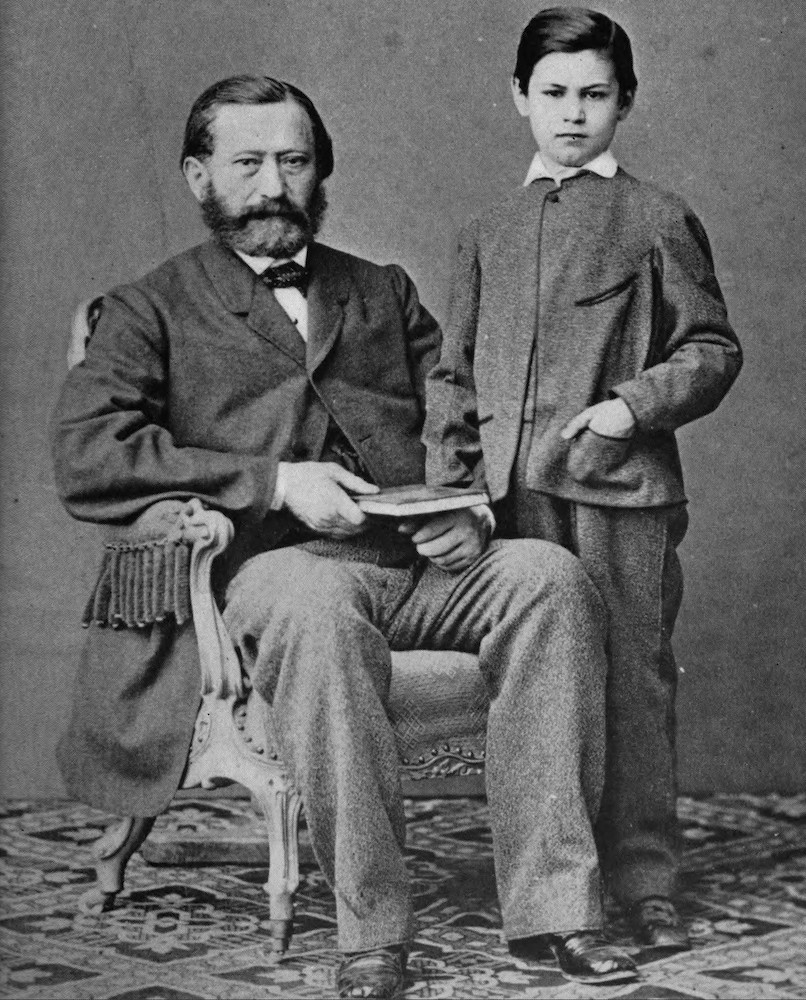
Freud, aged eight, with his father, 1864 (APA, facing p.10).
1865. Freud enrolled in Leopoldstadter Gymnasium. Will pass all exams in Greek, Latin, Ancient History and Classics, English and French, Dante, Goethe, Shakespeare, Chemistry, Biology and much more [1873].
1866. Birth of final sibling, Alexander, named from a "Family Council" meeting dominated by Sigmund's rich knowledge of Greek History. [1901, 1902]
1870. Closely follows news of Franco-Prussian War, using maps etc. [1915]. Freud and school friend Eduard Silberstein return to Freiberg on visit to family of school friend Emil Fluss. Freud aged 17 years, has a first adolescent infatuation, with 15-year old Gisela Fluss [1872], known from childhood. The Silberstein Letters, long thought lost, would eventually surface and be published by Boehlich (ed.),1989. Freud's own share of correspondences etc. he several times took pains to destroy in the period 1885-1907, as noted by biographer Ernest Jones (I: Preface). [1885, 1907].
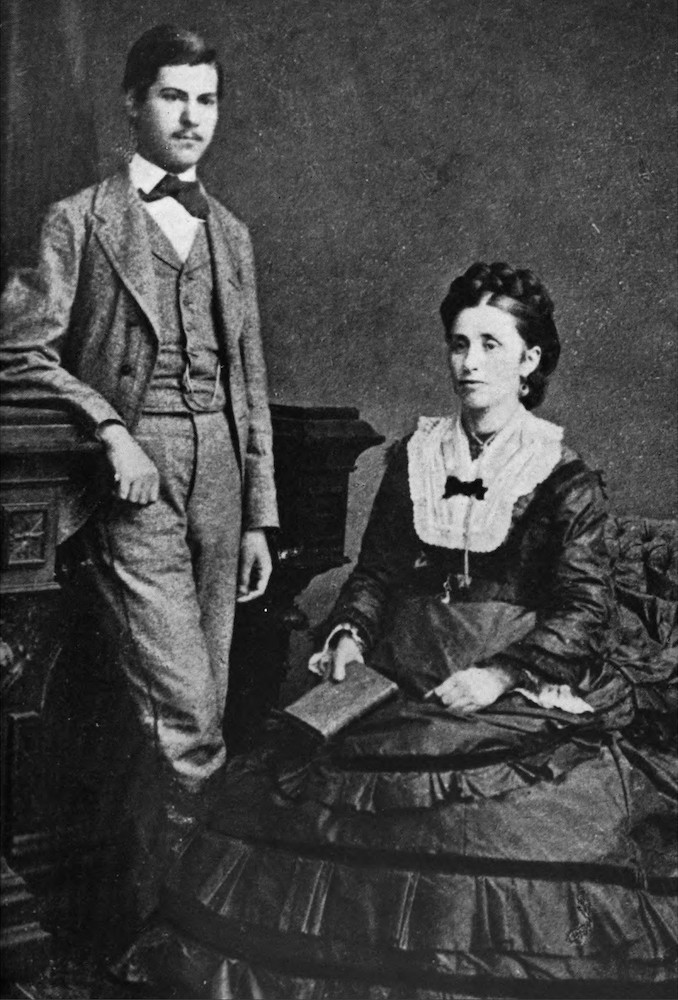
Freud, aged sixteen with his mother, 1872 (APA, facing p. 12)
1872. Second visit to Freiberg and the Fluss family, with Gisela Fluss again prominent. Much later Freud would analyse these visits and their "screen memories," and discover their true reason and motivation. [1858, 1897,1899].
1873. Graduates successfully from Gymnasium and enrols in the University of Vienna [founded in 1365, before Heidelberg, Cologne or Leipzig; and before Berlin, 1574]. With a late change of idea from Law & Jurisprudence, he chooses the Medical Faculty.
1874. Enters the orbit of Ernst Brücke, 1819-1892, Prof. Physiology and staunch advocate of empirical determinism and the influential Helmholtz School. Freud's courses include Franz Brentano's "Psychology From an Empirical Standpoint" [1888]; and "Biological Darwinism."
1875. Continues studies on Zoology, Physiology and Psychology. First visit to his half-brothers in Manchester [1860, 1908], and to his much admired England [1891, 1938].
1876. Awarded research grant to travel and study at Prof. Karl Claus's marine research-station at Trieste, Italy. On return he is accepted as a research scholar at Brücke's Institute of Physiology, with career advances to 1884.
1877. Tasked by Brücke to study the spinal chord of primitive vertebrate-Cyclostomate fish Petromyzon, with its puzzling Reissner cells. Freud demonstrated that the spinal ganglion cells were a "missing link," and thus provided continuity with higher vertebrate species.
1878. Brücke presents Freud's spinal chord results to a meeting of the Vienna Academy of Sciences in July, with publication one month later of an 86-page report in the Bulletin: Freud's first peer-reviewed science paper. Around this time Freud also made a significant new friendship, with older physician Josef Breuer, psychopathologist and frequently at the Institute of Physiology. [1880,1886, 1893, 1895]
1879. Further studies on vertebrate spinal chords; improves technical aspects of microscopy and histology; develops a new gold chloride stain for nervous tissues (Jones, 1953, Ch. 4: "Medical Student"). Is called for one year of compulsory military-training, 1879-80.
1880. Bored with military inactivity, Freud turned to translating some "Essays" of John Stuart Mill, three on social issues and one on Grote's edition of Plato. In July physician Breuer [1878] begins treatment of "Fräulein Anna O.," an intelligent 21-year old girl suffering a classic hysterical paralysis of the arm following her father's death. The case (1880-82) will become crucial to Freud's early development of psychoanalysis [1889, 1893, 1895], and he constantly reviews and extends his thoughts and interpretations from persistent conversations with Breuer, [Studies on Hysteria]
1881. Passes final medical examinations for M.D. on 30 March; graded as "excellent". Continues to pursue poorly-paid research interests at Brücke's Institute of Physiology, motivated by his ambition to make a famous discovery.
1882. According to Freud "the gloomiest and least successful year" of his professional life (Jones, Ch. 5: "Medical Career"). But in April he meets Martha Bernays, b.1861, in his parental home one evening, possibly accompanied by her sister Minna, b.1865. The two families were socially close, and Martha's grandfather Isaac Bernays had been Chief Rabbi of Hamburg. For Freud it was the beginning of a lifetime relationship; of a clandestine engagement owing to his poor earnings; and the stimulus (with Brücke's advice) to switch from research to general medical practice. [1886]
1883. Freud moves out of parental home, and into hospital residence. Begins circuit of General Hospital of Vienna departments in preparation for independence: Nothnagel's Dept. of Internal Medicine, followed by Psychiatric Clinic of Theodor Meynert, 1833-1892. Moves to Dept. of Dermatology, specialising in laboratory work of syphilitic skin conditions, owing to their connection with the central nervous system.
1884. Began the New Year in the Dept. of Nervous Diseases (Nervenabteilung), and also continued with new research on the then little-known alkaloid drug cocaine - from the dried leaves of the S. American shrub E. coca - and which he obtained from the Merck Drug Co. Studied its anaesthetizing properties, stimulant properties and others; published a thorough review "On Coca" in the July issue of Centralblatt für die gesammte Therapie, and spoke to a number of colleagues on the topic. Called away to holiday with his fiancée Martha, he was amazed on his return to find that a colleague from Ophthalmology, Carl Koller, 1857-1944, had successfully employed the drug in delicate eye-procedures. Desired fame continued to elude Freud.
1885. (January) Freud, supported by Brücke, Meynert and Nothnagel, finally applies for the coveted rank of Privatdozent. He is appointed Lecturer in Neuropathology, and in June presents his required public lecture - choosing "The Medullary Tracts of the Brain" - in the Lecture Theatre of the Brücke Institute. (October) Having gained a travel-research grant, Freud studies hysteria and hypnosis for several months in Paris with the great Jean-Martin Charcot, 1825-1893. This doyen of early neurologists, whom Freud called the "Master" (Jones, Ch. 10, "The Neurologist," 1883-97; E. L. Freud, 1960, Letter 93 to Martha Bernays), habitually demonstrated his patients in vivid states of hysteria, trance and hypnosis ["Mesmerism"]. Freud offers to translate from French to German a volume of Charcot's "Lessons," and is soon accepted into the great man's inner-circle (with Babinski, Guinon and others). Freud becomes convinced of the reality of hysterical symptoms; witnesses the impact of verbal suggestion, and performs/reports on cerebral autopsies. [1893]. Letter of 28 April to Martha Bernays notes him destroying much previous correspondence, diaries and mss. - though nothing of hers - and relishing the future difficulties of his many imagined biographers (Jones [1870, 1907]).
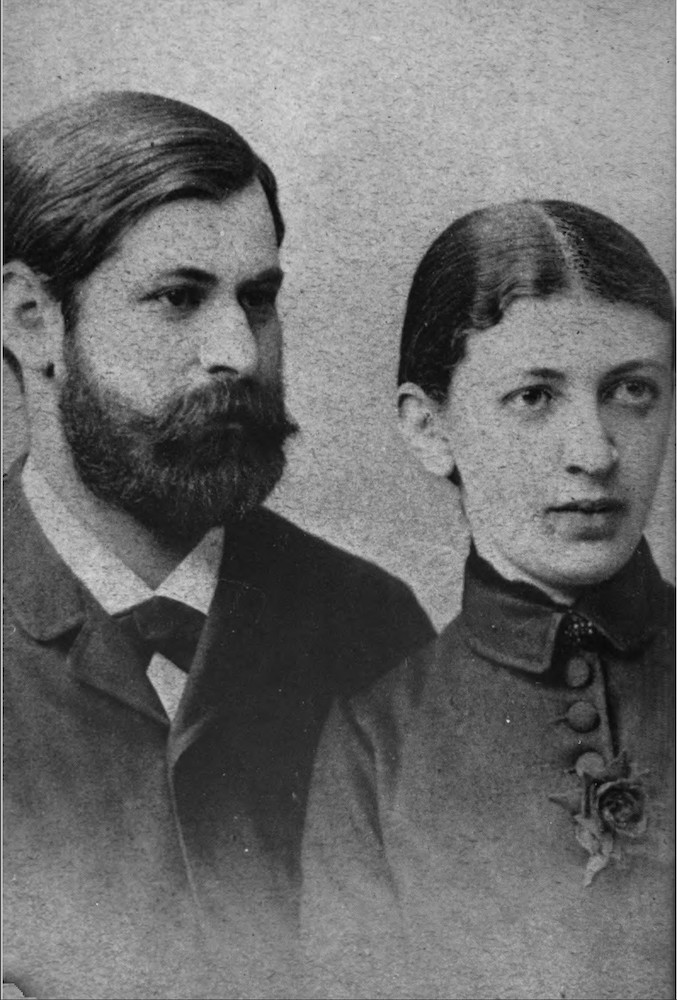
Marriage picture of Freud with his wife Martha, 1886 (APA, facing p. 15).
1886. (February) Leaves Charcot's Clinic in Paris and spends several weeks in Berlin studying children's diseases at a Clinic of Adolf Baginsky,1843-1918. In Vienna he will continue children's work, as Director of Neurological Studies at the non-University "Institute for Children's Diseases" of Max Kassowitz, 1842-1913. (April) Begins his own private practice. (September) Marries Martha Bernays. (October) Lectures to Society of Physicians "On Male Hysteria" ["hysteric," SOED M17, from Greek husterikos, hustera = uterus], and is challenged by Meynert to produce such an impossible case, i.e. one with Charcot's visual, sensory or motor (but not "hystero-genic") symptoms. (November) Demonstrates such a case: a "classic hemi-anaesthesia" developed in a 29-year old metal-worker following an emotional argument with his brother. Typical confirmatory disturbances of eye and colour vision are independently assessed by ophthalmologist Leopold Konigstein. Freud, not withstanding, is subsequently ostracised by Meynert and many Viennese academics; will leave the learned "Gesellschaft" and enter upon a first decade of relative intellectual isolation, alleviated largely by family life and his friendship with Josef Breuer [1878], and by a growing platonic relationship with Wilhelm Fliess [1887].
1887. Freud's medical practice, largely with neurotics, hysterics and neurasthenics, sees him employing an assortment of hypnosis and therapeutic suggestion, faradic electrotherapy as per the standard texts of the day, with warm baths, rest and rejuvenation. He reviews books such as Weir Mitchell, The Treatment of Certain Forms of Neurasthenia & Hysteria, Lippincott & Co., 1884. Birth of first child, named Mathilde after Frau Breuer [1886]. (November) Start of friendship and intensive correspondence with Berlin specialist Wilhelm Fliess, 1858-1928 ["Bisexuality"]; this will come to act as Freud's sounding-board for his most intimate personal disclosures, self-analysis, and flights of new theoretical daring [1897, 1900, 1905] (Masson (ed.), 1985).
1888. Translates and adds polemical Preface to 1886 work on hypnosis of French physician Hippolyte Bernheim,1840-1919, of the Nancy school of therapy: Die Suggestion und ihre Heilwirkung (Suggestion and Its Healing Effect), S. E. I: 73-88). Freud applauded the effort to link hypnotism with "familiar phenomena of normal psychological life and of sleep ... (and) ... its bringing to light the psychological laws that apply to both classes of events." The lasting problems of hypnosis had thus been carried over "completely into the sphere of psychology" [1874].
1889. Freud begins treatment of "Frau Emmy von N.," whose pioneer analysis will appear in a later historic collection of early cases [1895]. Visits the clinic of Bernheim at Nancy, hoping to resolve/improve his own technique of hypnosis. [1887, 1888]. Freud's second child is born; named Martin after Charcot [1885].
1890. Growing relations with Fliess, via frequent lengthy letters and "congresses" in person, in Vienna and Berlin, or occasionally Dresden, Nuremberg and elsewhere[1895].
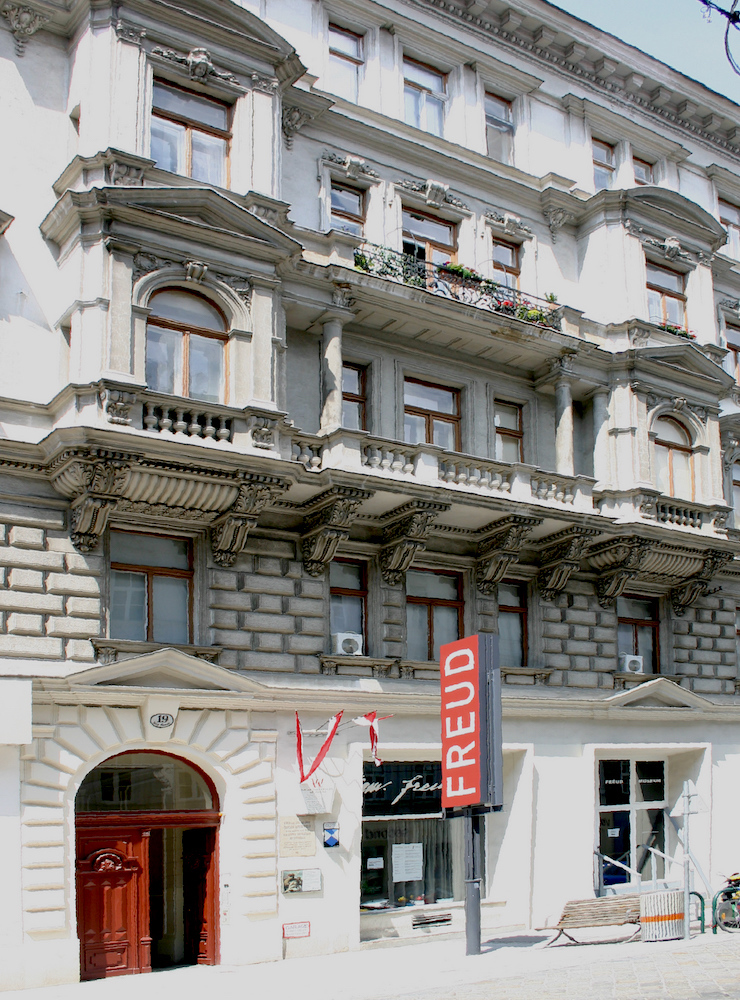
Freud House (Museum), Vienna. Photograph by Avinash Bhat, first posted on Flickr (Attribution-ShareAlike 2.0 Generic (CC BY-SA 2.0).
1891. Birth of third child, named Oliver [Cromwell] after Freud's esteem for all things English [1875, 1908]. Growing family moves to now famous apartment [Sigmund Freud House, Vienna] at Berggasse 19, until 1938. Publishes his outstanding work/monograph in neurology, On Aphasia, S. E. Vol. I. This shows already a move from the more mechanical Helmholtz School terminology [1874] - though not from the underlying determinism - together with Freud's growing liking and flair for psychology, with experiences-processes-ideas as functional factors [cognitive symbols would be added a decade later, [1900, 1901]]. Very few copies were taken over the next nine years [cf. 1900]. Rather better-received was the 1891 monograph on infantile cerebral palsies authored with his friend Dr. Oskar Rie. [Both men would have daughters who became childhood friends and psychoanalysts: Anna Freud and Marianne Rie (Kris)].
1892. Birth of fourth child, Ernst, named after Brücke. Intensification of exchanges with Fliess, both men using the other as a sounding-board (and therapist?). As Fliess increases in importance to Freud, Breuer declines, though there were strong theoretical-treatment conflicts emerging with the latter [1893]. Begins treatment of "Elisabeth von R"., who appears in the later Studies [1895]; she proves refractory to hypnosis, and Freud experiments with an early "psychical analysis" combining listening and suggestion.
1893. (January) With Breuer, publishes a "Preliminary Communication," later part of their Studies on Hysteria [1880, 1895]: they take the position that "hysterics suffer mainly from reminiscences". In April, F.W.H. Myers of the Society for Psychical Research will present a first account of this work [1911]. (February) Encloses "Draft B: Aetiology of the Neuroses" [S. E.: I] in a letter to Fliess in Berlin: Freud separates male and female aetiologies, and sees "a recognized fact that neurasthenia is a frequent consequence of an abnormal sexual life." Birth of Sophie Freud, named after a niece of Samuel Hammerschlag, Freud's revered Gymnasium teacher of Religion. Death of Charcot in August, [1885], and publication (September) of Freud's seven-page detailed appreciation: "Charcot," S. E.: I. Beginning of Freud's cardiac symptoms; Fliess urges him, with part-success, to quit smoking/chewing cigars. A future mouth cancer awaits him [1923].
1894. "The Neuro-Psychoses of Defence" (S. E.: III). Freud's publication emphasises the sexual aetiology, further exacerbating his divergences from Breuer [1893]. Freud's dependence on Fliess increases [1887], though only temporarily (Defence Theory: Anxiety & Unpleasure). [1895] (A later dependence, even more temporary, would be that upon C. G. Jung [c.1908-c.1912].
1895. (January) "On the Grounds for Detaching a Particular Syndrome from Neurasthenia Under the Description 'Anxiety Neurosis.'" (April) Meets Fliess in Dresden; repeated in late August at Salzburg. (May) Publication of Breuer and Freud's joint-work Studies on Hysteria, S. E.: II. The work consists of the prior "Preliminary Communication" [1893], and five full case-histories. (July) Staying at Bellevue, Vienna, on Wednesday 25th Freud dreams his famous "dream of Irma's injection," which he will discuss at length in a major work [1900]. (September) Visits Italy with brother Alexander - Padua, Bologna; Florence and the Galileo Museum; Ravenna, though not yet Rome [1901]. (Dec.) Birth of final child, Anna, apparently named after a daughter of Samuel Hammerschlag [1893]. "Project for a Scientific Psychology," S. E.: I - after a September "congress" with Fliess in Berlin, Freud drafted his neurological-psychological based "Project," and sent it to Fliess in October. It contained an economic-quantitative element "Q" for neurone function, and showed its author's grounding in the empiricism of the Helmholtz School. Other letters to Fliess, often with enclosed lengthy Memoranda, showed early developments in Freud's ideas on melancholia, paranoia, phobias, obsessive acts and rituals.
1896. (March) First appearance of the term "psycho-analysis," in Heredity and the Aetiology of the Neuroses, S. E.: III, in which Freud presented his flawed "seduction theory" of neuroses, based on his taking the assertions of patients as fact rather than phantasy, as he later explained at length (Freud, 1925). The paper did also usefully maintain that "hysterical symptoms are over-determined." (April) The seduction theory was not well received, by Krafft-Ebing and others at Freud's presentation to the Vienna Society for Psychiatry and Neurology. It had first surfaced in May 1893 as merely a suspicion to Fliess, and was maintained to September 1897 (Jones, I, Ch. 14. "Self-Analysis," citing unpublished Fliess letters). (October) Death of father, Jacob Freud, whose illness in summer had led Freud to cancel a "Fliess congress." Freud's subsequent brooding would lead to his crucial "Self Analysis"; even more expiatory correspondence with Fliess, and to important theoretical advances [1897, 1900, 1905].
1897. Pioneering Self-Analysis. Jones (1953, I: Ch. 14 ) sees this beginning with the "Irma" dream of mid-1895, though with more rigour from July 1897 (citing unpubld. Fliess Letters). Death of Jakob Freud [1896], and lifelong fascination with Dreams contributed, and the self-analysis proceeded in close parallel with Freud's research/writing on the eventual dream book [1900]. On returning to Vienna from his summer holiday Freud announced the demise of his "seduction theory," and cited fantasy material recovered from dreams of his erotic early playmates [1858], and of his naked mother on a night train [1860], (Masson, ed., 1985, Letters of September 21 and October 3,1897). Other dreams concerned his early nanny [1858]: "She was my teacher in sexual matters," and he later noted "One single thought of general value has been revealed to me ... falling in love with the mother and jealousy of the father," (Masson, ed. Letters of 4 and 15 October, 1897). From his wider education he linked this material to "the riveting power of Oedipus Rex" [1910], and to Shakespeare's character Hamlet [1907, literary analysis].
1898. Year largely spent in self-analysis and expanding the mss of his forthcoming dream book, [1900]. More "congresses" with Fliess. In free time (since ostracised from the university [1886]) he enjoyed a weekly evening of four-handed cards ("tarock") with Konigstein, Oskar Rie [1891] and others; and visits to the B'nai B'rith Society (Jewish Lodge). Zionism - Freud's attitude here was always muted though lifelong, from childhood poring over the Torah, to his enduring identification with the biblical Moses and a final eponymous major book [1937]. He could not have ignored the international scandal of the "Dreyfus Affair" 1894-1906, nor the founding of the new Zionist Movement by Austrian Theodor Herzl, 1860-1904, in 1897 at Basle in neutral Switzerland. Freud apparently never wished to go to the "Balfour (1917) Declared" homeland of Palestine, though his close friend Max Eitingon and others did. His major biographer notes that when Freud was safely settled in London in 1938, his visitors included Professor Yahuda, the learned Jewish scholar, and Chaim Weizmann, 1874-1952, "...the famous Zionist, whom Freud held in the highest esteem," (Jones, 1957, III: "London - The End"). A passion for Freud was archaeology; at Innsbruck that summer he bought a Roman statue, an interest both aesthetic and for his "fondness for the prehistoric in all human manifestations" (Jones, 1953: I, Ch. 15, "Personal Life," citing Letter to Fliess, 20 August 1898). About this time Freud's work became known to the English sexologist Henry Havelock Ellis, 1859-1939, [see Victorian Sexual Theories], and the two men would periodically exchange letters for the next three decades, a correspondence still unpublished and apparently lost.
1899. More work to finish the dream book. Publishes Screen Memories, S. E.: III, showing the wealth of affective material that may be disguised behind apparently innocent childhood scenes: Gisela Fluss [1872] is depicted, in her idyllic adolescent family setting, with a yellow dress "the colour of dandelions," though Freud admits "there was something else that excited me powerfully...." Later analysis would recover Gisela's mother, and then his own latent maternal-oedipal phantasy. (November) Publication of the massive tome Die Traumdeutung (The Interpretation of Dreams). Publisher Franz Deuticke of Vienna chooses to place the date "1900" on the title-page, and this is accepted by Freud in all citations of the work.
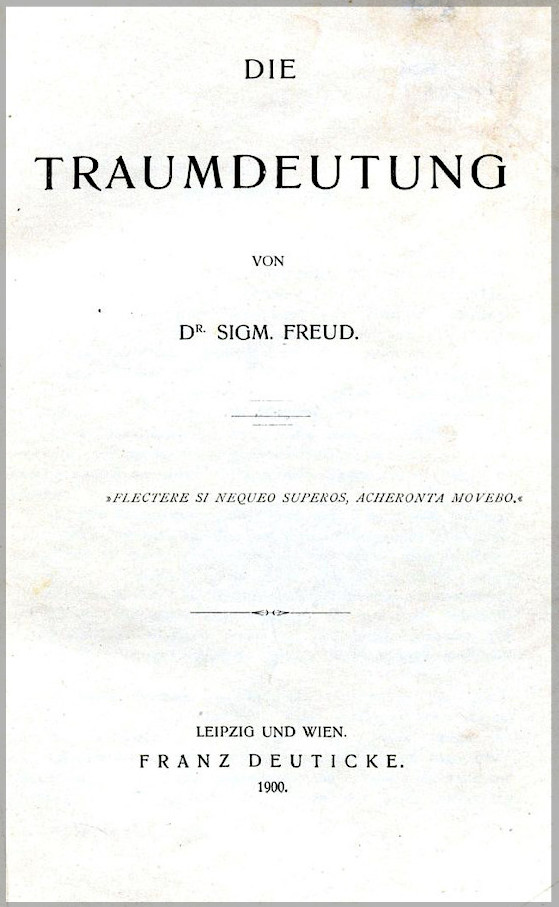
The "dream book" published in late 1899, bearing the date 1900: copy from the International Psychoanalytic University, Berlin, in theInternet Archive.
1900. The Interpretation of Dreams (Die Traumdeutung). S. E. IV-V: "A new psychology of Unbewussten Denken (Unconscious Thought)." To Freud dreams were his via regia or "royal road" to the unconscious, his most original book and one of two he liked best (Jones, 1953, I: 16, citing personal meeting). [Dream Psychology]. The other favourite book was Freud's Three Essays on the Theory of Sexuality [1905]. (October) "Dora," eighteen-year-old Ida Bauer, enters analysis with Freud: the first of some five or six great case-histories will result. [cf. "Dora" 1905, "Little Hans" 1909, "The Rat Man" 1909, "Leonardo" 1910, "Schreber"1910, "The Wolf Man" 1918].
1901. (January) Completes writing of "Dora" case but delays publication [1905]. Publishes his shorter popular work On Dreams, S. E.: V; his examples of children's dreams, with obvious wish-fulfilment, include one of strawberries by his little daughter Anna, from 1897. (July-August) Publishes his general study of memory lapses, errors and slips, initially in two journal parts: The Psychopathology of Everyday Life; S. E.: VI; the book will appear in 1904. With Alexander Freud he finally visits Rome, despite neurotic conflicts of identification with Hannibal's ancient war against the city; visits art galleries, museums and historic sites [1902, 1913].
1902. (March) Finally appointed Professor. (October) Begins meetings of the new Wednesday Psychological Society, at the Berggasse apartment [1891], following the suggestion by Wilhelm Stekel who had studied with Krafft-Ebing and attended Freud's University lectures. Other early members, doctors and university colleagues of Freud, were Rudolf Reitler and Max Kahane; and Alfred Adler, a Viennese physician. [Wednesday had been the crucial day of Freud's vital "dream of Irma" [1895. Cf.1908]. Again with Alexander [1866, 1901] he visits Italy - Naples, Venice, Pompeii, Vesuvius. Death of Richard von Krafft-Ebing, 1840-1902, of Strasbourg, Vienna and the famous Psychopathia Sexualis: see Victorian Sexual Theories. With a "Triumvirate" of the more significant deaths completed - Brücke [1892], Charcot [1893], Krafft-Ebing [1902], together with his own father in1896 - Freud should now have been free of external shrines of tutelage and discipleship. He would end the Fliess relationship [1904] and break into international recognition [1909]. The anomaly of C. G. Jung would still disturb him [1907-1913].
1903. Continues relatively isolated and unknown beyond Vienna. Poor sales of the larger work on dreams continue poor. Relations with Fliess [1886,1887 et seq.] have largely cooled. Freud's family, friends and the little Wednesday Society sustain him. Paul Federn joins the small group, and in 1905 will introduce Eduard Hitschmann, both Viennese.
1904. World-wide psychological attention is drawn to the behavioural "reflex psychology" of Russian experimentalist Ivan Petrovich Pavlov, 1849-1936, the year's recipient of the Nobel Prize for Physiology and Medicine [1919]. Freud terminates the Fliess correspondence/relationship with a final letter. Otto Gross of Graz enters Freud's circle. (Autumn) Hears from Swiss psychiatrist Prof. Eugene Bleuler of Zurich. Bleuler and colleague Carl Gustav Jung, had followed Freud's initiatives since 1902, applying them to their own work on schizophrenia etc. [1907]. Freud (1925) would correctly acknowledge Bleuler's priority on the important concept of "ambivalence."
1905. A major publishing year: Three Essays of the Theory of Sexuality, and A Case of Hysteria["Dora"], both in S. E. Vol. VII; and Jokes and Their Relation to The Unconscious, S. E. VIII. The first child-analysis case, that of "Little Hans" [1909], also began in this year (Dyer, 1983, p. 6, citing Anna Freud). Eduard Hitschmann joins the Vienna Psa. Society. [The year saw Einstein's "Special Theory of Relativity" paper in German; and Binet and Simon's improved Binet-Henri intelligence-test for the Paris Schools Authority: all examples of Victorians, Habsburgians and similar, continuing to shape the New Era. Also in France, Henri Matisse's "Fauves" begin their art-breakout; in Russia there is the "Bloody Sunday" massacre in St. Petersburg, the battleship Potemkin mutiny, and formation of the first workers-soviet; in the U. S. A. the first five-cent cinema or "Nickel Odeon" opens in Pittsburgh, and the Battle Creek Toasted Cornflake Co. is started by a Dr. Kellogg, while in England the British Pensions Act arrives, giving rise to "dancing in the streets" and in fields "always sunny and golden" (1985:reminiscences of present writer's grandmother [born 1900] as a 5-year old)].
1906. (April) Freud begins correspondence with Jung [McGuire, ed., 1974], thanking him for a gift-copy of Diagnostiche Assoziationsstudien (Diagnostic Studies in Association) [1902-1906], with its confirmatory examples of affective interference [repression] in recall. Otto Rank joins the Wednesday Psychological Society, and is soon acting-secretary. Isidor Sadger also joins, and in 1907 will introduce his nephew Fritz Wittels, psychiatrist and co-worker of Prof. Julius von Wagner-Jauregg in Vienna.
1907. The last year, according to biographer Jones, (1953, Vol. I, Preface), in which Freud took pains to destroy much of his correspondence and other accumulated papers [1870, 1885], including in all probability his half of the Freud-Fliess correspondence. (January) Max Eitingon visits Freud from the Zurich group, and is followed in Spring by C. G. Jung whose personality makes an immediate impression upon Freud and his family, including the burgeoning Anna Freud. Publications include (April) Obsessive Acts and Religious Practices, prequel to Freud's culture-religion studies [1912-13, 1927, 1937]; and a pioneer [1897] literary analysis Delusions and Dreams in Jensen's "Gradiva", S. E. IX. (June) Karl Abraham of Berlin sends first letter to Freud; first visit in December. A new "Freud Group" in Zurich includes Jung, Prof. Eugene Bleuler, Alphonse Maeder, Ludwig Binswanger and others, meeting at Burghölzli Mental Hospital. (October) An obsessional young man, a lawyer, enters treatment with Freud and furnishes one of a small but crucial group of case-histories [1900, 1908].
1908. (April) Wednesday Psychological Society [1902] becomes the Vienna Psycho-Analytical Society (Wiener Psychoanalytischen Vereinigung), which continued to meet on Wednesdays. Also this year, suggested by Ernest Jones, when in Zurich in Nov. 1907, the First International Psycho-Analytical Congress: organized by Jung for Sunday 26 April at the Hotel Bristol, Salzburg. Historic early presentations were detailed in their original order by Jones (1955, Vol. II, "The Beginning of International Recognition, 1906-9"):
[Vienna] Freud. "Case History" [The Rat Man, 1907].
[Baltimore] Jones "Rationalization in Everyday Life."
[Zurich] Riklin. "Some Problems of Myth Interpretation."
[Berlin] Abraham. "Psychosexual Differences Between Hysteria & Dementia Praecox."
[Vienna] Sadger. "The Aetiology of Homosexuality."
[Vienna] Stekel. "On Anxiety Hysteria."
[Zurich] Jung. "On Dementia Praecox."
[Vienna] Adler. "Sadism in Life and In Neurosis."
[Budapest] Ferenczi. "Psycho-Analysis and Pedagogy."
Sandor Ferenczi had visited Freud in February, and quickly became a key figure in the new science. Freud's lecture lasted four hours without pause, and almost a further hour by demand, to "a rapt audience" around a large table (Jones). Freud's other short papers: "Creative Writers and Day-Dreaming," "Character and Anal-Erotism," "'Civilized' Sexual Morality and Modern Nervous Illness," and "On The Sexual Theories of Children," all in S. E. IX. (Sept.) Freud again visited England [Manchester, 1875], including London; and made a stop in Zurich to see Jung. The Berlin Psa. Society dates from now, with Karl Abraham, Otto Juliusburger and Max Eitingon prominent. Mosche Wulff is learning psa. technique.
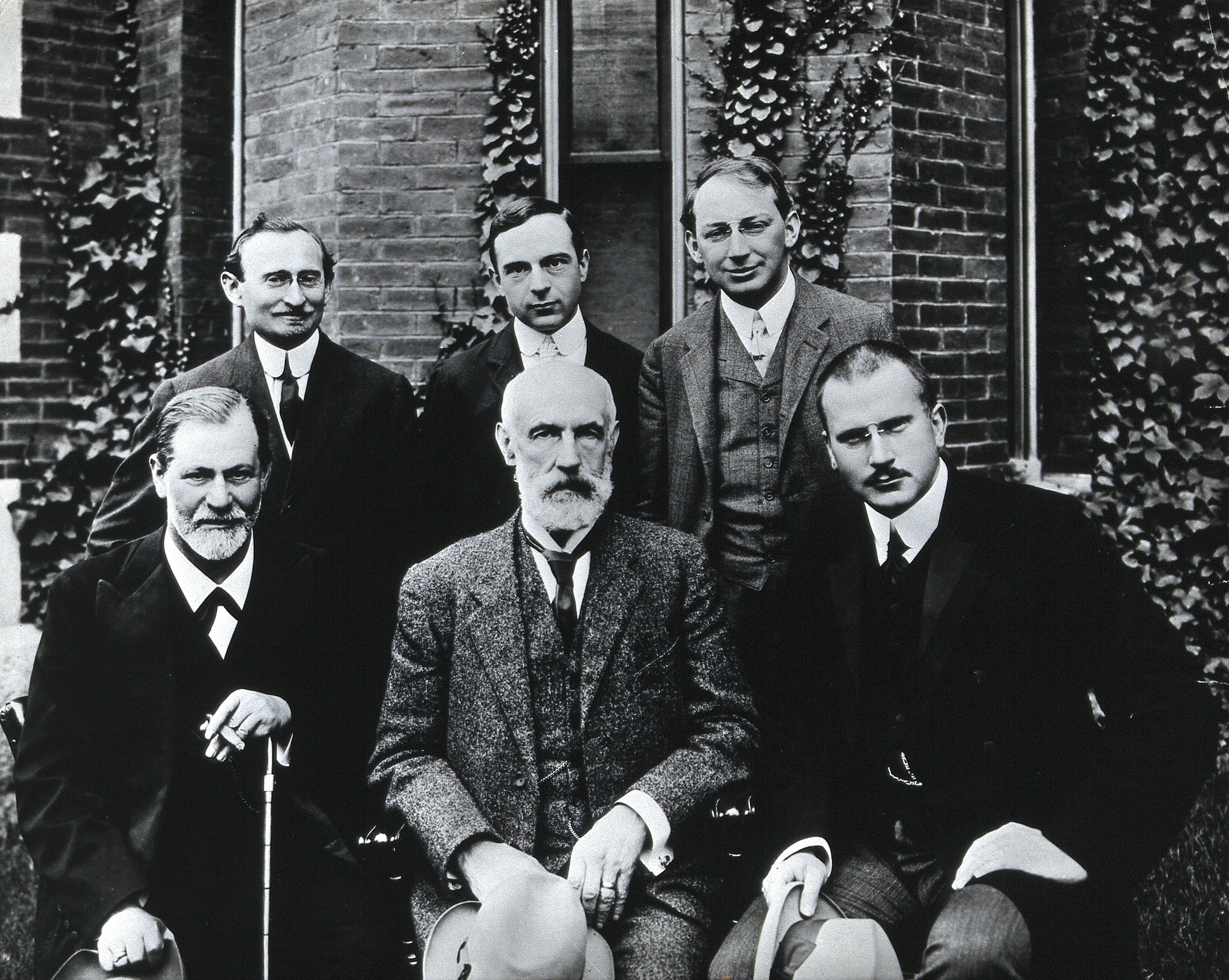
Freud, Stanley Hall, Jung, Abraham Arden Brill, Ernest Jones and Sándor Ferenczi, in 1909. Photograph from the Wellcome Collection. Attribution 4.0 International (CC BY 4.0).
1909. Jung edits newly-founded Jahrbuch für psychoanalytic und psychopathologische Forschungen (Yearbook for Psychosomatic and Psychopathological Investigations), which leads with Freud's pioneering child case "Analysis of a Phobia in a Five-Year-Old Boy" ["Little Hans"]. The child's father, Max Graf, had been an early member of the original Wednesday Psychological Society, and Freud's methodology was to largely employ the father as intermediary. Hans's phobia was of horses. Freud also published his "Rat Man" case, in Part 2 of Jung's new Yearbook: 'Notes on a Case of Obsessional Neurosis'; the two comprise S. E. Vol. X. Swiss pastor Oskar Pfister makes a first visit to Freud. Viktor Tausk approaches Freud. (September) More international recognition sees Freud invited by Prof. G. Stanley Hall, President of Clark University, Worcester-MA, to receive an honorary degree and to give a series of presentations: Five Lectures on Psycho-Analysis, S. E. XI. Jung and Ferenczi accompanied Freud to America, sailing from Bremen on the Norddeutscher Lloyd liner George Washington. Another participant and loyal supporter there of the new dynamic psychology was J. J. Putnam, of Harvard University. Freud would himself later describe his moving encounter with American philosopher-psychologist William James, 1842-1910, who told him on parting "The future of psychology belongs to your work," (Freud, 1925). Already "The Psycho-Analytic Movement" was beginning, and would strongly influence Twentieth-Century thought [Sigmund Freud: Introduction].
1910. (February) A wealthy young Russian enters a prolonged analysis with Freud, and will become famous as "The Wolf Man" [1918] in another of Freud's most notable cases [1900]. First woman member, Margarete Hilferding, joins the Vienna Psa. Society; better-known ones will follow [1911, 1913]. The Russian Psa. Society is formed in Moscow by Osipov, and a new journal Psychotherapia from 1909 accepts papers and reviews on psychoanalysis. Ukrainian-born Ludwig Jekels hosts a summer vacation for Freud's unmarried daughters Sophie and Anna, with their Aunt Minna Bernays. Jekels would soon move from Bistrai to Vienna, becoming prominent as one of a generation - including Friedjung, Viktor Tausk, Hermann Nunberg, Herbert Silberer and Alfred Winterstein - which Anna Freud would later view as her "seniors," (Freud, A.,1969k; Dyer,1983, p. 15 et seq.). The young Theodor Reik also meets Freud. (March) Second International Psa. Congress, at Nuremburg. Differences emerge with the Swiss, especially Jung, who is made President of the International Psa. Association; has the aura of "Crown Prince" and Freud's successor [1902 and Freud's neurosis]; and is opposed especially by Adler and Stekel. Freud publishes an English edition of his American lectures [1909]; and a study of Leonardo da Vinci and a Memory of His Childhood, an early psychobiography; both now in S. E. Vol. XI. In his short paper A Special Type of Object-Choice Made by Men. Contributions to The Psychology of Love, Pt. I he made his first published use of the concept of "the Oedipus complex," as noted by Peter Gay,1989, p.392n1 [1897].
1911. In the U. S. A. Psa. Societies were already forming in Baltimore (Ernest Jones, Putnam, Adolf Meyer, Trigant Burrow) and New York City (A. A. Brill, Clarence P. Oberndorf, Beatrice Hinkle and H. W. Frink). At the Third International Psa. Congress, held in Weimar in September, Beatrice Hinkle joined Putnam and Brill among Americans, whilst a notable number of other women in the fifty-five guests included Emma Jung, Antonia Wolff, Mira Gincburg, Maria Moltzer, Martha Boddinghaus and the formidable Lou Andrea-Salomé. Other female students of analysis at this time included Tatiana Rosenthal and Sabina Spielrein, both of the Zurich group. Freud's presentation was his "Schreber Case," Psycho-Analytic Notes on an Autobiographical Account of a Case of Paranoia, S. E., Vol. XII. Jones (1955, Vol. II, "The International Psycho-Analytic Association""), notes that at Weimar, he and Hanns Sachs took pains to visit Frau Elisabeth Förster-Nietzsche, sister and biographer of the icon [Nietzsche]. Sachs's comment to her, on the similarity between some of the ideas of Freud and her famous brother, were prescient by some fourteen years, before Freud's own acknowledgement in his "Autobiography" of 1925. Freud is made an Honorary Member of the London Society for Psychical Research [1893]. Papers this year included Formulations on the Two Principles of Mental Functioning, in S. E. XII: reaffirms Freud's dynamic/economic dual model of Mind. [Primary Process/Pleasure Principle and Secondary Process/Reality Principle, the former largely Unconscious-Irrational-Illogical, the latter largely Conscious-Rational-Logical. 1895, 1900. Dream Psychology]. (June) Adler resigns in Vienna; Stekel controversial; Jung begins to drift away: Dissensions. (December) The Handling of Dream Interpretation, S. E., Vol. XII, a revision of analytic technique and first in an important series to 1915. [1937]
1912. (March) Publishes The Horror of Incest, the first of four anthropological Parts [to 1913] appearing in the new periodical Imago. Further Parts to the eventual book Totem und Tabu [1913], were: (2) "Taboo and the Ambivalence of Feelings," comparing as before similarities between primitive tribal prohibitions and those of modern obsessional neurotics. (3) "Animism, Magic and the Omnipotence of Thoughts," where the ancient magician's power is shown to dwell in the omnipotence of men's wishes. (4) "The Infantile Return of Totemism." More dissensions, with Zurich in particular, persuade Ernest Jones to advance the idea of an inner "Committee" of trusted analysts, to act as "a kind of Old Guard around Freud," (Jones, op. cit.). The group comes to include Rank, Sachs and Freud in Vienna, Ferenczi in Budapest and Abraham in Berlin, together with Jones who will shortly relocate to London [1919 Eitingon (Berlin)]. Freud gives each Committee member a small Greek intaglio from his collection, to be made into a "symbolic ring." Towards year's end Lou Andreas-Salomé [1911] arrives in Vienna to study with Freud; Stekel finally resigns, and Freud founds a new journal for greater control over his own science publications - Internationale Zeitschrift für ärtzliche Psychoanalyse (International Journal for Medical Psychoanalysis), thereafter often termed "the Zeitschrift." Hermine Hug-Hellmuth begins contact with Freud.
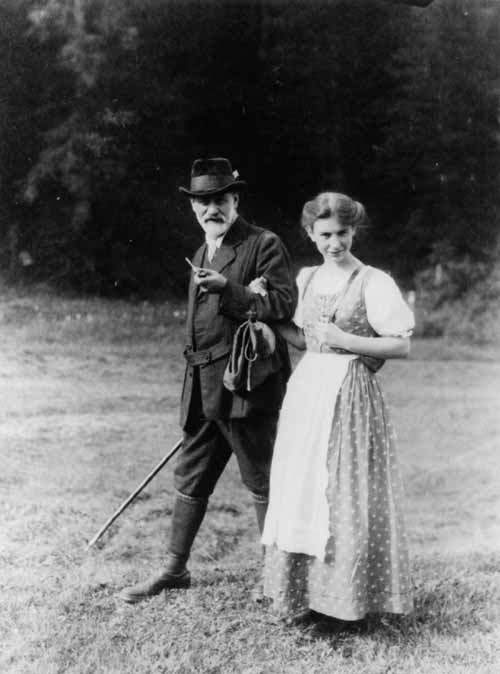
Freud with his daughter Anna in the Dolomites, 1913. Library of Congress image, digital ID cph.3c17972, via Wikimedia Commons.
1913. First half of year largely spent on further parts [1912] to his major book on culture/applied psycho-analysis Totem and Taboo, S. E., Vol. XIII. (May) Budapest Psa. Society, with Sandor Ferenczi, Istvan Hollos, Sandor Rado and Lajos Levy, is accepted into the International Psa. Association. (October) also accepted is the London Psa. Society, with Douglas Bryan, David Eder, David Forsyth, and Ernest Jones as President; five other members had never practised psychoanalysis. Refusals were sent by social psychologist William McDougall, 1871-1938, of Cambridge, Gottingen and Oxford; and by sexologist Henry Havelock Ellis,1858-1939, who had been studying Freud's works in German since the 1890s. [Victorian Sexual Theories]. (September) Fourth International Psa. Congress - "The Munich Congress" - brings the differences with Jung to a forlorn and disagreeable head. After much persuasion, Freud agreed to read his paper The Predisposition to Obsessional Neurosis, which established the anal-sadistic pre-genital phase of libido development. After the Congress, Freud travelled to see Rome again [1901], with his interesting and intelligent sister-in-law Minna Bernays joining his train at Bologna. For "seventeen delicious days," Freud mixed sightseeing with writing, including a Preface for the forth-coming major work on totemism, myth and religion. Helene Deutsch becomes part of Vienna psychoanalysis [1920].
1914. 1914. Final break with Jung, who resigns as President of the International Psa. Association in April. Freud publishes final version of his pivotal paper On Narcissism: An Introduction, S. E. XIV, which he had drafted in Rome 1913, and which presaged his later fuller structural Ego Psychology of the 1920s. Allows his daughter Anna to leave from Hamburg for England as late as 18th July 1914 (the Austrian Archduke Franz Ferdinand and his wife had been assassinated on 28th June) - and she would only get home safely, after the outbreak of General War, by the efforts of Ernest Jones and others to have her included in the returning Austrian Ambassador's party, (Dyer, 1983, pp. 20-22). Around this time, Karen Horney in Berlin migrates to psychoanalysis, as does Hermann Nunburg in Vienna.
1915. With his sons in uniform at the front or elsewhere, and the early "jingoism" [1870] faded, Freud's mind turned to his little-known Thoughts for The Times on War and Death. He had often previously been preoccupied with such sombre thoughts, as his biographers relate, but then so had many others in an age of high infant mortality, contagious illnesses, pneumonia and tuberculosis. Edvard Munch, 1863-1944, had shown this truth in several of his early paintings of sick children. Freud continued to produce key "Metapsychological" papers: (March)Instincts and their Vicissitudes, Repression and The Unconscious, S. E. XIV.[1917] Several were destroyed unpublished, as his mind slowly advanced from a dynamic-economic model to a fully structural-metapsychological model [1920, 1921, 1923]. Began his pedagogical series of Introductory Lectures on Psycho-Analysis, Series I, S. E. XV. [Over the next two years the young Anna Freud would quietly attend most of these.]
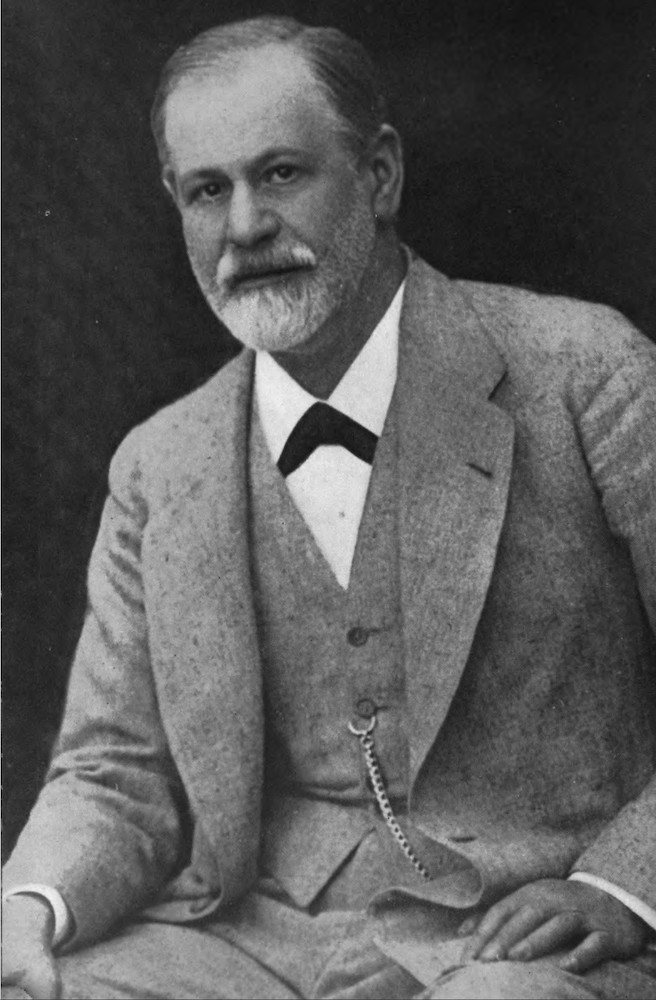
Portrait photograph of Freud, aged 60, in 1916 (APA, facing p. 21).
1916. Privations in Vienna. Letters, food-parcels and cigars arrive via friends in neutral countries. Freud had long since decided that "endurance becomes the chief virtue," and had confided in a letter to Lou Andreas-Salomé that he saw "the highest civilization of the present as disfigured by a gigantic hypocrisy" (Jones, 1955, II: "The War Years," citing Letter of Nov. 1914). About this time Georg Groddeck enters Freud's circle.
1917. Mourning and Melancholia, and A Metapsychological Supplement to the Theory of Dreams, S. E., Vol. XVII.
1918. Finally publishes From the History of an Infantile Neurosis, his "Wolf Man" case [1910], originally written in 1914: S. E. XVII. Military authorities now show interest in Freud's therapy (for their numerous "shell shock" and "war neuroses" cases). Ernst Simmel, a high-ranking army medical officer, attends the Fifth International Psa. Congress, held in Budapest (September); Anna Freud [1908], now aged twenty-four, accompanies her father who had also recently become her (covert) training-analyst, indicating a future course of events [1922]. English Modernist writer Virginia Woolf, 1882-1941, learns of Freud and Sexual Psychology from friend Lytton Strachey, 1880-1932, [Dora Carrington], who attends meetings of the British Society for Sex Psychology, Hampstead & Bloomsbury [1913]. Younger brother James Strachey [Victorian Sexual Theories: Bisexuality, Rupert Brooke] will enter analysis with Freud in Vienna (1930s) and eventually translate Freud's works [S. E.]. Vera Schmidt adopts psychoanalytic ideas around now.
1919. Anton von Freund, a wealthy Hungarian industrialist in analysis with Freud, provides funds to establish an independent Verlag or Psychoanalytic Publishing House. His death in 1920 will deprive Freud of much needed support, just as the cessation of hostilities in late 1918 had removed military interest and financing. Behavioural psychologist J. B. Watson, 1878-1958, publishes Psychology From the Standpoint of a Behaviourist, in contradiction to Freud's model of Mind [1904].
1920. (September) Sixth International Psa. Congress, held in The Hague, Holland. Anna Freud again with Freud. Of the twenty papers presented, five were from women: Drs. Helene Deutsch and Hermine Hug-Hellmuth of Vienna; Eugenia Sokolnicka, Sabina Spielrein and Margarete Stegmann [see Gender Matters]. The paper by "Prof. Sigm. Freud" was Supplements to The Theory of Dreams. Far more important was Freud's book Jenseits des Lustprinzips (Beyond the Pleasure Principle, S. E. XVIII), in which he introduced the notion of a "death instinct" into the fundamental [Helmholtz] posit of dualism-conflict-constancy in the organism. Freud used the "Nirvana Principle" of English psychoanalyst Barbara Low, alongside the previous Helmholtz-Fechner "Principle of Constancy." Freud's title indicated an unspoken debt to Nietzsche, and the latter's Jenseits von Gut und Böse (Beyond Good and Evil) of 1886. [1913,1925]. More acceptable than a "death instinct" opposing any positive ego-libido instinct, Freud also now arrived at his concept of "repetition-compulsion," adducing many examples. Memorandum on the Electrical Treatment of War Neurotics, at the request of the Special Commission of the Austrian Military, was Freud's denunciation of the existing punitive methods.
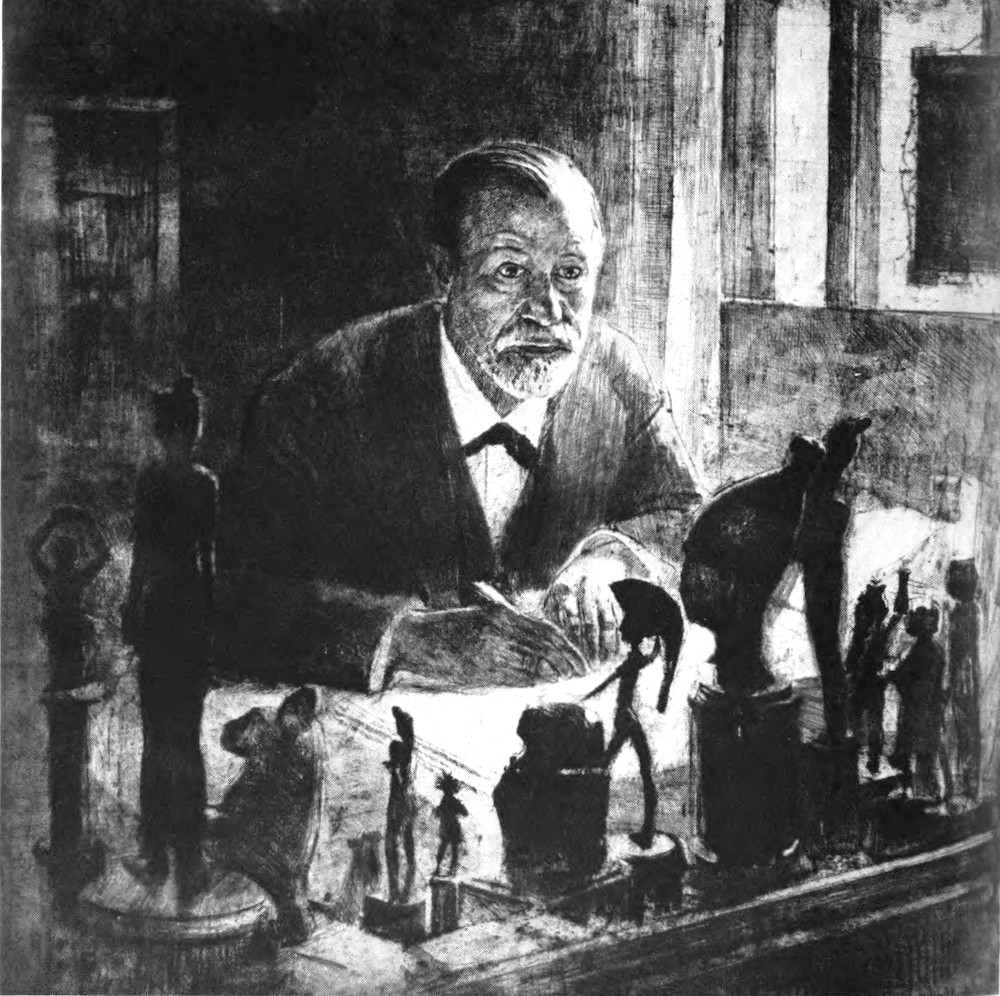
Max Pollack's etching of Freud from life, Vienna, 1921 (APA, facing p. 59).
1921. Group Psychology and the Analysis of the Ego, S. E. XVIII. Jung offers Psychological Types, with the dualism of extrovert-introvert.
1922. Seventh International Psa. Congress, in Berlin. The last Freud will attend, owing to illness. Daughter Anna Freud finally presents her required opening contribution to the Vienna Psa. Society: Schlagephantasie und Tagtraum, (Beating Phantasies and Daydreams), whilst legitimately withholding the identity of the teenage-girl subject, in fact herself, in analysis with her father. The material develops longitudinally the earlier ideas in Freud's A Child is Being Beaten of 1919.
1923. Year of Freud's classic The Ego and the Id (S. E. XIX), completing his structural model of 1920. (April) Start of his prolonged jaw-cancer illness. (September) Visits Rome [1901 et seq.] with Anna Freud. Otto Rank [1906] publishes The Trauma of Birth; begins own trauma of eventual open schism with Freud.
1924. Eighth International Psa. Congress, at Salzburg [1908]; both Freud (ill) and Anna absent. Fritz Wittels [1907] visits Freud and "mends bridges,"
1925. Ninth International Psa. Congress, at Bad Homburg. Anna Freud reads her absent father's Some Psychological Consequences of the Anatomical Distinction Between the Sexes [see Gender Matters] [1931]. An Autobiographical Study, S. E. XX, has Freud's mature judgements on many earlier matters. Death of Abraham [1907] keenly felt. Schism with Rank.
1926. Inhibitions, Symptoms and Anxiety, S. E. XX, a difficult presentation of Freud's often revised views on "defence," repression, anxiety and aetiology. [1894-1915-1925. U.S. edition as The Problem of Anxiety]. Rank leaves Vienna for New York. Freud receives seventieth birthday messages, including from the Hebrew University of Jerusalem of which he is a Director.
1927. Tenth International Psa. Congress, Innsbruck. Anna reads the absent Freud's paper, "Humour," followed by her own first to "the International." The "patriarchal robe" of psychoanalysis, spurned by Jung [1914] and by Rank [c.1924], had found a more loyal inheritress. Freud's major work: The Future of an Illusion, is a forceful critique of Religion [1929].
1928. Travels to Berlin for new consultation on his jaw cancer. Ernst Simmel [1918] was also now based in Berlin, at his Sanatorium Schloss Tegel, which had become "almost a second home for the Freuds," (Dyer, op.cit., p.86).
1929. Eleventh International Psa. Congress, Oxford, England. Attended by Anna; no paper by Freud, who is completing his polemical Civilization and Its Discontents, S. E. XXI. [1927].
1930. Publication of Freud's polemic [1929]; with previous one [1927] on religion, these will eventually comprise S. E. XXI. Freud is awarded the Goethe Prize of the city of Frankfurt.
1931. Freud completes Female Sexuality, late in life and always a struggle against his own socio-cultural grounding in masculinity [1925]. His female followers such as Helene Deutsch of Vienna and Karen Horney of Berlin, should be read as a corrective. [see Related Material and Bibliography below].
1932. Difficulties with Wilhelm Reich, who will emigrate to the U.S.A.; and with an increasingly ill and unbalanced Ferenczi. Prompted by the League of Nations, Freud and Einstein publish a joint-letter, Why War?. Owing to financial difficulties of the Verlag publishing house, Freud begins a further series, of New Introductory Lectures on Psycho-Analysis, S. E., XXII.
1933. Nazi victory in German parliament; break-up of Berlin Psa. Society; Eitingon [1907] leaves for Palestine. Freud's books burned in Berlin. Death of Ferenczi [1908]. Publication of Freud's "New" lecture-series [1932]; begins writing on his deeply-embedded Moses topic [1937-38].
1934. Situation in Austria worsens; Freud immersed in his Moses identification.
1935. Freud's letter recommends the works of Havelock Ellis [1898] to a mother of a homosexual son (Jones, 1957, III: "Last Years in Vienna, 1934-38"]. Freud works on his Moses.
1936. Recurrence of Freud's cancer, with major surgery needed. Increasingly he sees his mantle passing to his daughter Anna Freud, who is a Vice-President of the International Psa. Association; leader of a Child Analysis School, and now publishes a major theoretical work on mechanisms of defence. [Nunburg, Defence Theory].
1937. (February) Writes obituary for death of Lou Andreas-Salomé [1911]. Publishes Part I: "Moses an Egyptian," of an eventual book which will admit "an historical kernel" as partial counter to the "illusion" [1927] which he viewed as commanding the religion of many. Part II is published at the end of the year. (June) Technical paper on "Analysis Terminable and Interminable," in which he sombrely leans to the latter view, S. E., XXIII. At year's end he writes the short but prescient Splitting of the Ego in the Process of Defence, unpublished in his lifetime.
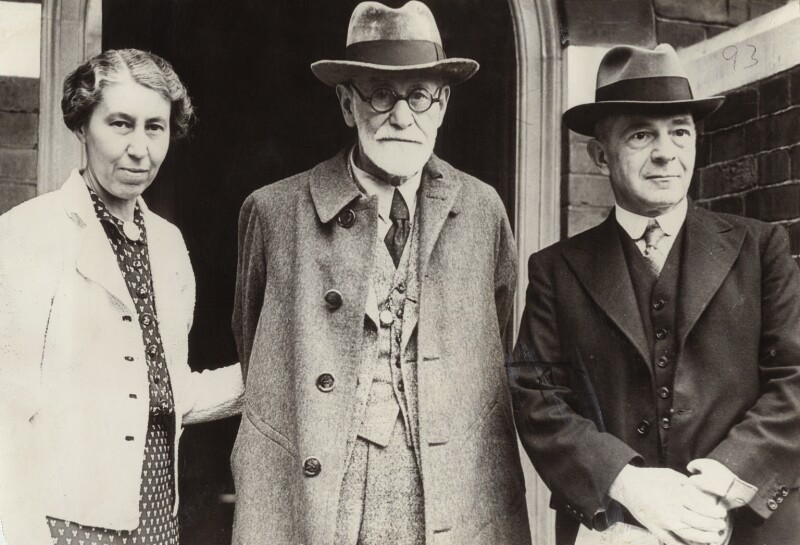
Press print of Freud with daughter Mathilde and Ernest Jones, 1938, © National Portrait Gallery, London, NPG x135930, by kind permission.
1938. (March) Tumult in Austria. Ernest Jones, Princess Marie Bonaparte of Paris and the French Psa. Society, and other friends persuade Freud to prepare to leave. He completes final Part III: "Moses, His People and Monotheist Religion" for the work Moses and Monotheism, published in August at Amsterdam. S. E. XXIII. (June) Freud, his wife and Anna take the train to Paris, with protection of Marie Bonaparte. On arrival in England by night boat, Jones drives them to London. By September they are at Freud's final dwelling, 20 Maresfield Gardens, Hampstead, N.W. London [now the Freud House Museum]. Freud continued with a small number of patients (four analyses daily) over the winter. Early visitors included H. G. Wells, Salvador Dali, three secretaries of the Royal Society, Eitingon, and Chaim Weizmann [1898].
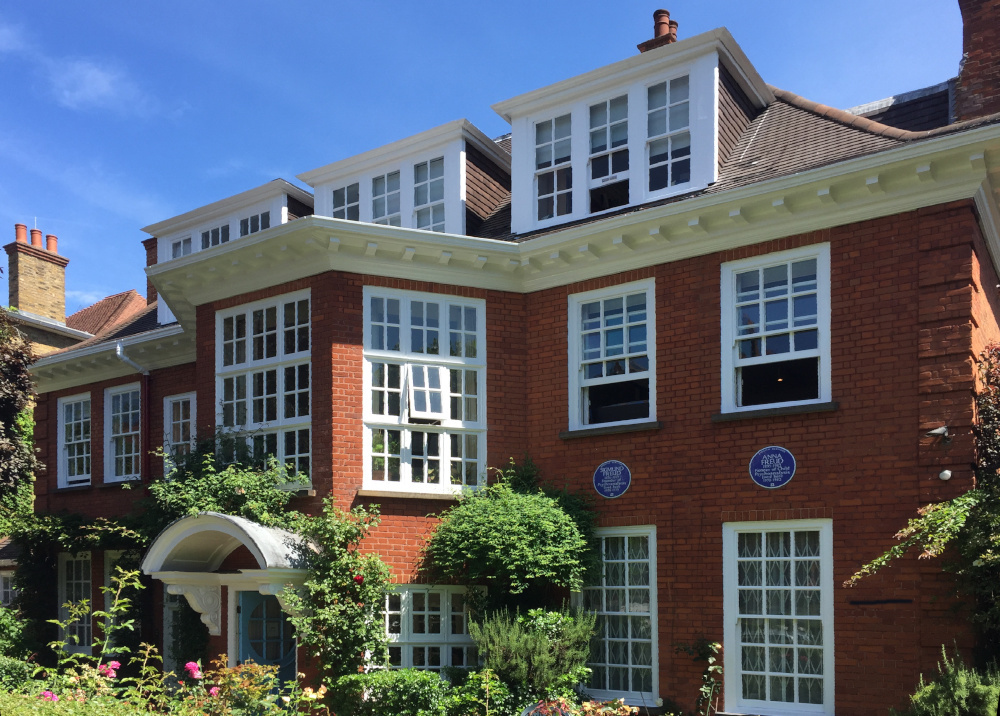
The house in Hampstead. Photograph by John Kannenberg available on the Attribution-NonCommercial-NoDerivs 2.0 Generic (CC BY-NC-ND 2.0) licence.
1939. Visitors to the Freud house include other emigrating analysts: Heinz Hartmann, Herman Nunburg, and from America now, Hanns Sachs. Freud's final writing is An Outline of Psychoanalysis, unpublished until 1940. His final reading is Balzac. In September, after a final hand wave to the visiting Ernest Jones (and no doubt later to an unknowing Anna and Martha Freud), Freud completes his previous pact with physician Schur, and takes a last decision, to exit his last war. With doubts as to how the coming war, and the westward extent of Nazi forces might proceed, Freud had chosen neither Paris nor London as repository for his substantial correspondence and other papers. They were all to be lodged at the Library of Congress, Washington D. C. where they are to this day. Inevitably therefore, his daughter Anna would pledge her own papers and correspondence to the same www.Sigmund Freud Archive, "so that they will be with my father's" (Letter of Anna Freud to the present writer, 15 August, 1976). Anna Freud's letters to the present writer form an Appendix to my dissertation, Anna Freud and Education. My letters to her are in Box 18 [D], The Anna Freud Papers, Library of Congress, Washington D. C.

Freud's ashes, in his own urn, at Golders Green Crematorium. Photograph by JB. Click on the image for more details.
Related Material
- Sigmund Freud: The Father of Psychoanalysis (a brief biography)
- Sigmund Freud: A Brief Timeline
- Freud's Preface to the Second Edition of The Interpretation of Dreams
- Freud and the Great War
- Freud and the Helmholtz School
- Victorian Theories of Sexuality
Bibliography
Boehlich, W., (ed.). The Letters of Sigmund Freud to Eduard Silberstein, 1871-1881. Cambridge, MA: Harvard University Press, 1989.
Dyer, R. Anna Freud and Education. PhD Thesis. University of Sheffield, 1980.
_____. Her Father's Daughter. The Work of Anna Freud. New York & London: Jason Aronson Inc., 1983.
Fliess, W. See Masson, J. M.(ed.)
Freud, A. "An Appreciation of Hermann Nunburg," in Psychoanalytic Psychology of Normal Development. The Writings of Anna Freud. 8 vols. 1969. London: Hogarth Press; New York: I. U. P., 1982.
Freud, E. L. (ed.) Letters of Sigmund Freud, 1873-1939. New York: Basic Books, 1960.
Freud, S. The Interpretation of Dreams. Transl. A. A. Brill. Macmillan. 1913.
_______An Autobiographical Study. In S. E., Vol. XX.
Gay, Peter. The Freud Reader. New York: Norton & Co., 1989.
______.Freud. A Life For Our Time. New York: Norton & Co., 1988.
Jones, Ernest. The Life and Work of Sigmund Freud. 3 vols. New York & London: Basic Books, 1953, 1955, 1957.
Jung, C. G. See McGuire, ed.
Leupold-Lowenthal, H., ed. Sigmund Freud House Bulletin. Vol. 1--. Vienna: Sigmund Freud Gesellschaft, 1975--.
Masson, J. M., ed. The Complete Letters of Sigmund Freud to Wilhelm Fliess, 1887-1904. Cambridge, MA & London: Belknap Press, 1985.
McGuire, W., ed. The Freud-Jung Letters. Transl. by Ralph Mannheim & R. F. Hall. Princeton: Princeton University Press, 1974.
Paskauskas, R. A., ed. The Complete Correspondence of Sigmund Freud and Ernest Jones, 1908-1939. Cambridge, MA: Belknap Pres, Harvard, 1993.
Silberstein, E. See Boehlich, W.
S. E. (The Standard Edition of the Complete Psychological Works of Sigmund Freud), eds. James Strachey, Anna Freud et al. In 24 vols. London: Hogarth Press & Institute of Psychoanalysis: and New York: I. U. P., 1954-73.
Illustrations
American Psychoanalytic Association [APA] and Naomi Katcher. The Freud Centenary Exhibit of the American Psychoanalytic Association, Commemorating the One Hundredth Anniversary of the Birth of Sigmund Freud, May 6, 1856-May 6, 1956. New York, 1956. Hathi Trust, from a copy in the University of Michigan Libraries. Web. 18 February 2021.
Created 18 February 2021; last modified 18 August 2023